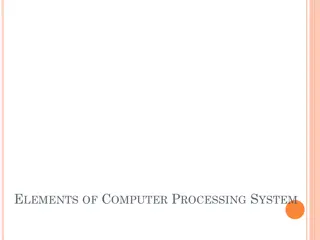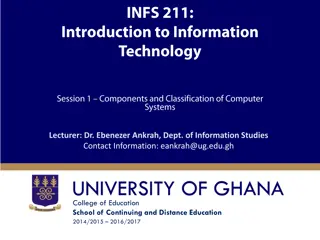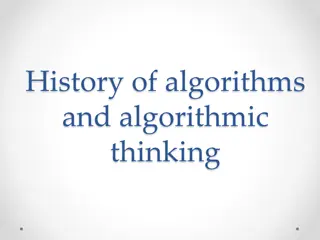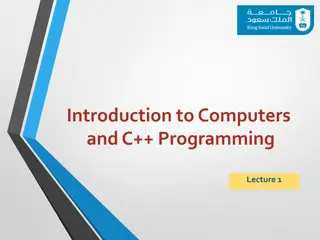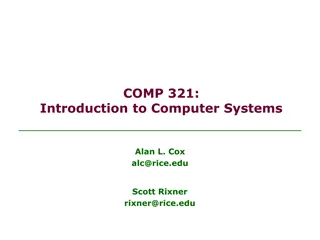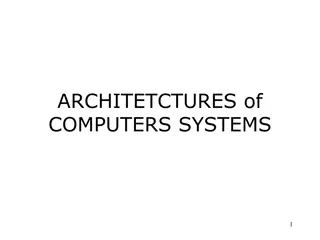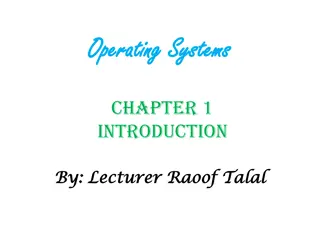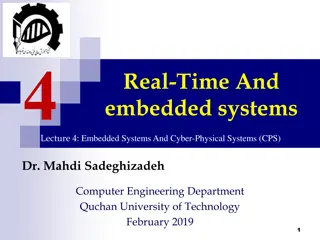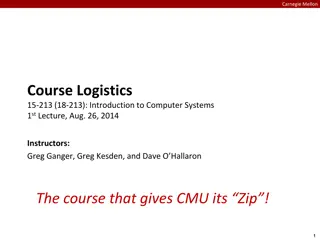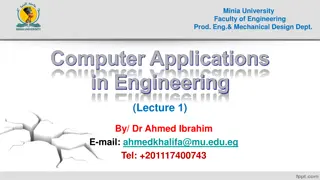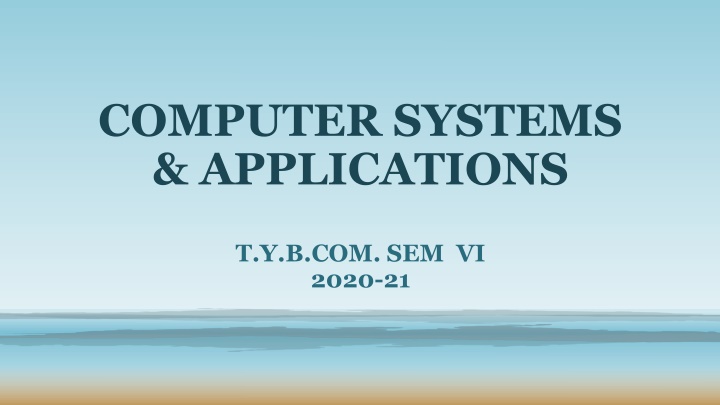
E-Commerce Systems and Applications: Topics, Marks Allocation, Advantages, Disadvantages
Explore the world of E-commerce systems and applications as covered in the course for T.Y.B.COM. Semester VI. Delve into the topics, marks allocation, advantages, disadvantages, and features of E-commerce with a focus on online business practices, security issues, encryption, payment modes, and more. Understand the definition, benefits, drawbacks, and scope of E-commerce in the digital age.
Download Presentation

Please find below an Image/Link to download the presentation.
The content on the website is provided AS IS for your information and personal use only. It may not be sold, licensed, or shared on other websites without obtaining consent from the author. If you encounter any issues during the download, it is possible that the publisher has removed the file from their server.
You are allowed to download the files provided on this website for personal or commercial use, subject to the condition that they are used lawfully. All files are the property of their respective owners.
The content on the website is provided AS IS for your information and personal use only. It may not be sold, licensed, or shared on other websites without obtaining consent from the author.
E N D
Presentation Transcript
COMPUTER SYSTEMS & APPLICATIONS T.Y.B.COM. SEM VI 2020-21
Topics & Marks Allocation Sr. No Topic Name E-commerce MS-Excel Visual Basic Questions allotted 1 2 3 18 20 12
FAQ on E-Commerce E-Commerce, Its Advantages & Disadvantages (Limitations) Features of E-commerce Types of E-commerce Business Models in E-commerce B2C Models Security issues in E-commerce Encryption & Decryption Payment modes in E-commerce
E-Commerce Definition E-Commerce information and communication technology. is the process of doing business electronically, using Electronic Commerce means buying and selling of products or services by businesses and consumers over the internet. E-commerce is the business environment in which information for buying, selling and transportation of goods and services moves electronically. E-commerce means selling and buying products and services through web storefronts. E-commerce is a modern business methodology. It addresses the needs of organizations, merchants and consumers to cut cost and to improve the quality of goods and services.
Advantages 1. Reduced Cost 2. Time Saving 3. Lower advertising cost 4. Global scope 5. Better quality of products 6. Equal opportunities for all merchants 7. Online Payments 8. Availability
Disadvantages 1. All products not bought online 2. Security 3. Expensive to maintain the website 4. Technological limitations 5. Fulfillment problems 6. Hacking 7. Virus
Features of E-commerce: Ubiquity: Global Reach: Universal Standards: Information richness: Interactivity: Information Density: Customization: Social technology:
Features of E-commerce: Ubiquity: Global Reach: Universal Standards: Information richness: Interactivity: Information Density: Customization: Social technology:
Scope of E-commerce: Electronic Market EDI (Electronic Data Interchange) Internet Commerce
EDI EDI or Electronic Data Interchange is the virtual exchange of data or business documents in electronic format between trading partners. This exchange of documents is generally between buyer and supplier and consists of transferring purchase orders, invoices, payments, shipping notices and various other documents and by nature eliminates paper trails, improves operational efficiency and enhances virtual exchanges with new trading partners. With EDI, any company can virtually interact with another organisation anywhere in the world without the hassle of waiting times and forecasting future procedures.
Steps in an EDI System Following are the steps in an EDI System. A program generates a file that contains the processed document. The document is converted into an agreed standard format. The file containing the document is sent electronically on the network. The trading partner receives the file. An acknowledgement document is generated and sent to the originating organization.
Advantages of an EDI System Following are the advantages of having an EDI system. Reduction in data entry errors. Chances of errors are much less while using a computer for data entry. Shorter processing life cycle Orders can be processed as soon as they are entered into the system. It reduces the processing time of the transfer documents. Electronic form of data It is quite easy to transfer or share the data, as it is present in electronic format. Reduction in paperwork As a lot of paper documents are replaced with electronic documents, there is a huge reduction in paperwork. Cost Effective As time is saved and orders are processed very effectively, EDI proves to be highly cost effective. Standard Means of communication EDI enforces standards on the content of data and its format which leads to clearer communication.
Types of E-Commerce Business To Business (B2B) Shop2gether.com , SeekandSource.com Business To Consumer (B2C) Amazon.com , Flipkart.com Consumer To Consumer (C2C) Ebay.com, Olx.com Peer To Peer (P2P) BitTorrent.com,
Business Revenue Models Advertising Revenue Model Yahoo.com, Rediff.com Subscription Revenue Model Consumerreports.org Transaction Revenue Model Ebay.com, sharekhnan.com Sales Revenue Model Amazon.com, Flipkart.com Affiliate Revenue Model Mypoints.com
B2C Models Portal (MSN.com, yahoo.com) E-tailer (Amazon.com) Content Provider (Timesofindia.com) Transaction Broker (Naukri.com) Market Creator (ebay.com) Service Provider (Google Maps, Orkut, Gmail) Community Provider (Facebook, twitter)
E-Commerce Security Issues Integrity Ensures no changes or alteration Non Repudiation No denial from both the parties Authenticity Ensures the identity of person Availability Available all the time Confidentiality Ensures privacy of data
Encryption & Decryption Encryption Converting Plain Text to Cipher Text Decryption Converting Cipher Text to Plain Text Private Key Encryption Same Key is used to encrypt & decrypt Public Key Encryption Two keys are used. Private Key for decryption Public Key for encryption
Payment Modes Digital Cash Online Stored Value System Digital Accumulating Balance Payment Digital Credit Card System Digital Checking Digital Wallets
Other Terms SSL (Secure Socket Layer) HTTPS Digital Signatures Online Credit Card Transactions SET(Secure Electronic Transaction) M-Commerce
MS-Excel Functions String Date Statistical Counta() Countblank() Countif() Correl() Large() Small() Cond. Lower() Upper() Proper() Len() Trim() Left() Right() Mid() Fixed() Today() Now() Date() Time() Day() Month() Year() Weekday() Days360() If() Sumif() Averageif()
MS-Excel Functions String Date Statistical Counta() Countblank() Countif() Correl() Large() Small() Conditional If() Lower() Upper() Proper() Len() Trim() Left() Right() Mid() Fixed() Today() Now() Date() Time() Day() Month() Year() Weekday() Days360() Sumif() Averageif()
MS-Excel String Functions LEN() It returns the number of characters in string E.g. = LEN( EXCEL ) will return 5 LEFT() It returns the left most n characters from text value. E.g. = LEFT( COMPUTERS ,3) will return COM RIGHT() It returns the right most n characters for text value. E.g. = RIGHT( LIVE ,1) will return E MID() It returns n number of characters from mthcharacter position of the text string E.g. = MID( COMPUTER ,4,3) will return PUT
MS-Excel String Functions LOWER() It coverts text into lower case. E.g. = LOWER( EXCEL ) will return excel UPPER() It coverts text into upper case. E.g. = UPPER( excel ) will return EXCEL PROPER() It capitalizes 1stcharacter in each word of the text value E.g. = PROPER( STRING FUNCTION ) will return String Function
MS-Excel String Functions TRIM() It removes all spaces from text E.g. = TRIM( FINAL EXAM ) will return FINAL EXAM FIXED() Rounds a number to the specified number of decimals, formats the number in decimal format using a period and commas, and returns the result as text. Example : FIXED(1234.567, 1) returns 1,234.6 FIXED(-1234.567, -1) returns -1,230
MS-Excel Date & Time Functions NOW() It returns the current Date and Time. E.g. = NOW() will return today s date & time i.e. 4/23/2021 11:30 TODAY() It returns the current Date. (mm/dd/yyyy) E.g. = TODAY() will return today s date i.e. 4/23/2021 DATE() It returns a particular date. E.g. = DATE (2020,1,12) will return 1/12/2020 (January 12, 2020)
MS-Excel Date & Time Functions TIME() It returns a particular time in hh:mm AM/PM form E.g. = TIME(12,0,0) will return 12:00 PM DAY() It returns the day of the month corresponding to the serial_number. The day given as an integer ranging from 1 to 31 E.g. = DAY( 1/5/2021 ) will returns the value 5 as it is the 5th day of month Jan MONTH() It returns the month corresponding to serial_number. The month is given as an integer ranging from 1 to 12. E.g. = MONTH( 1/4/2021 ) will returns the value 1 as it is the 1stmonth of year
MS-Excel Date & Time Functions YEAR() It returns the year corresponding to serial_number. The year is given as an integer ranging from 1900 to 9999 E.g. = YEAR( 1/4/2021 ) will return the value 2021 WEEKDAY() It returns the day of the week for a date. The day is given as an integer, ranging from 1 to 7. DAYS360() It returns the number of days between two dates based on a 360 day year (i.e. twelve 30 day month), which is used in some accounting calculations. E.g. = DAYS360( 1/30/20 , 2/1/20 ) will return 1, as Jan is considered a 30 days month
MS-Excel Statistical Functions COUNTA() The COUNTA function counts the number of cells that are not empty in a range. COUNTBLANK() The COUNTBLANK function counts empty cells in a specified range of cells. CORREL() The CORREL function returns the correlation coefficient of the Array1 and Array2 cell ranges. Use the correlation coefficient to determine the relationship between two properties. LARGE() The LARGE function returns the k-th largest value in a data set. You can use this function to select a value based on its relative standing. SMALL() The Excel Small function returns the k'th smallest value from an array of numeric values.
MS-Excel Statistical Functions COUNTIF() The Excel Countif function returns the number of cells within a supplied range, that satisfy a given criteria. Syntax : =COUNTIF( range, criteria ) AVERAGEIF() The Excel AVERAGEIF function finds the values in a supplied array that satisfy a specified criteria, and returns the average (i.e. the statistical mean) of the corresponding values in a second supplied array. Syntax : =AVERAGEIF( range, criteria, [average_range] ) SUMIF() The Excel Sumif function finds the values in a supplied array, that satisfy a given criteria, and returns the sum of the corresponding values in a second supplied array. Syntax : =SUMIF( range, criteria, [sum_range] )
MS-Excel Logical Functions IF(): The Excel IF function tests a supplied condition and returns one result if the condition evaluates to TRUE, and another result if the condition evaluates to FALSE. Nested IF() : The IF Function can be Nested which refers to a formula where at least one IF Function is nested inside another to test for more than one condition which in return give more possible results. So, in nested IF Statements you must be very careful because each IF Statement needs to be nested inside another, so the logic is correct.
MS-Excel Logical Functions AND() : The Excel AND function tests a number of supplied conditions and returns: TRUE if ALL of the conditions evaluate to TRUE Or FALSE otherwise (i.e. if ANY of the conditions evaluate to FALSE). OR() : The Excel OR function tests a number of supplied conditions and returns either: TRUE if ANY of the conditions evaluate to TRUE Or FALSE otherwise (i.e. if ALL of the conditions evaluate to FALSE).
MS-Excel LookUp Functions LOOKUP() Function The Excel LOOKUP function performs an approximate match lookup in a one- column or one-row range, and returns the corresponding value from another one-column or one-row range. The Microsoft Excel LOOKUP function returns a value from a range (one row or one column) or from an array. Syntax : =LOOKUP (lookup_value, lookup_range, [result_range])
MS-Excel LookUp Functions HLOOKUP() Function Searches a value from horizontal policy table The Microsoft Excel HLOOKUP function performs a horizontal lookup by searching for a value in the top row of the table and returning the value in the same column based on the index_number. The HLOOKUP function is a built-in function in Excel that is categorized as a Lookup/Reference Function. It can be used as a worksheet function (WS) in Excel. Syntax : =HLOOKUP (lookup_value, lookup_table, ,row_number[range_lookup])
MS-Excel LookUp Functions VLOOKUP() Function Searches a value from vertical policy table The VLOOKUP function performs a vertical lookup by searching for a value in the first column of a table and returning the value in the same row in the index_number position. The VLOOKUP function is a built-in function in Excel that is categorized as a Lookup/Reference Function. It can be used as a worksheet function (WS) in Excel. Syntax : =VLOOKUP (lookup_value, lookup_table, ,col_number[range_lookup])
Advanced features MS-Excel Filter Filtering data in MS Excel refers to displaying only the rows that meet certain conditions. (The other rows gets hidden.) This is a quick way to display only the information that is needed by you. You can Filter data in a Range, table or PivotTable. Excel provides two ways of filtering data AutoFilter Advanced Filter
Advanced features MS-Excel Charts Graphical representation of numerical data . Chart Types Column Chart Bar Chart Line Chart Pie Chart XY Chart Chart elements
MS-Excel What-If Analysis Excel includes many powerful tools to perform complex mathematical calculations, including what-if analysis. This feature can help to experiment and answer questions with different data, even when the data is incomplete. What-if analysis is the process of changing the values in cells to see how those changes will affect the outcome of formulas on the worksheet.
MS-Excel What-If Analysis Goal Seek A Goal Seek is a tool that is used to find an unknown value from a set of known values. Note :- Goal Seek can be used only with one variable input value. The set cell should always be the resulting cell. To value should always have a numeric value. Solver Solver comes with Excel as an add-in. Solver is used to find an optimal value for a formula in a cell called the target cell on a worksheet.
MS-Excel What-If Analysis Scenario Manager Scenario Manager is a what-if analysis tool available in excel which works on different scenarios provided to it, it uses a group of ranges which impact on a certain output and can be used for making different scenarios such as well bad and medium depending on the values present in the range which impact the result. A scenario is a set of values that Excel saves and can substitute automatically in cells on a worksheet. You can create and save different groups of values on a worksheet and then switch to any of these new scenarios to view different results.
MS-Excel What-If Analysis Macros : Macros are the tool that automates the tasks and saves time and reduces errors. A Macro is a program that copies keystrokes or mouse actions that are repeated and are common in the sheet. In short, Excel Macros refers to the programming language in VBA (Visual Basic Application ). Macros are short programs written in VBA. We can record/write macros in VBA and can run a macro by clicking the Macros command on the Developer tab on the ribbon. Macros are written to automate tasks and save time and assure efficiency.
Other Terms in MS-Excel Excel Template: A Microsoft Excel template is a predesigned sheet with a fixed format and default settings where most of the work is done for us. The templates is saved with the extension .xltx. Ranges in Excel A cell is a single element in a worksheet that can hold a value, some text, or a formula. A cell is identified by its address, which consists of its column letter and row number. Named Range in Excel : An Excel Named Range is created by allocating a chosen name to a specified range of cells. Once defined, the named range can then be used in functions and formulas, instead of the standard cell reference. Named Range just makes the process of working with formulas very interesting, especially to keep track of things.
VB Visual Basic is a third-generation event-driven programming language first released by Microsoft in 1991. BASIC means Beginners' All-purpose Symbolic Instruction Code. Visual Basic is a user-friendly programming language designed for beginners, and it enables anyone to develop GUI window applications easily. Visual Basic (VB) is useful in developing windows, web and device applications. Visual Basic is a fully Event-driven and visual programming language.
Components of Visual Basic Object An object is a type of user interface element you create on a Visual Basic form by using a toolbox control. In fact, in Visual Basic, the form itself is an object. Every Visual Basic control consists of three important elements Properties : A property is an attribute of an object that defines one of the object's characteristics, such as size, color, or screen location, or an aspect of its behavior, such as whether it is enabled or visible. To change the characteristics of an object, we can change the values of its properties. Methods : A method is an action that an object can perform. For example, Add is a method of the ComboBox object that adds a new entry to a combo box. Events : An event is an action recognized by an object, such as clicking the mouse or pressing a key, and for which you can write code to respond. Events can occur as a result of a user action or program code, or they can be caused by the system. Code that signals an event is said to raise the event, and code that responds to it is said to handle it.
Types of files in a VB Project Visual Project consist various files as follows: .vbp file: This file is called the project file, is a small text file that holds the names of the other files in the project, as well as some information about the VB environment. .frm file: Each form in the project is saved in a file with .FRM extension.. A from holds the description of all objects and their properties for each form, as well as the basic code that you have written to respond to the events. These are also referred as form modules. .bas file: Each project has this file. These file holds basic statements or programming code that can be accessed from any form. These files are called standard code modules. .ocx file: additional controls, called custom controls, are stored with a file .ocx extension. If we include controls in the projects that are not part of the standard control set, the .ocx file names will be included in the project. .vbw file: After the project is saves , Visual Basic automatically adds one more file to the project with extension of .vbw. This file holds information about each project s form.

![❤Book⚡[PDF]✔ The Apollo Guidance Computer: Architecture and Operation (Springer](/thumb/21611/book-pdf-the-apollo-guidance-computer-architecture-and-operation-springer.jpg)




